Supercharging Your Supply Chain with Artificial Intelligence
This article explains AI's “transformative potential” and includes insights into how AI tools can achieve mission-critical supply chain objectives.
Table of Content
In a recent blog post, Microsoft points out that machine learning and AI algorithms are old news in most digital arenas. Think – Netflix’s viewing recommendation engines, Spotify’s curated playlists, Amazon’s dynamic pricing.
While AI and ML are firmly embedded in our daily lives, the supply chain is still playing catch up on the artificial intelligence front. But – things are starting to change.
Given the challenging state of today’s global supply chains and the fast-moving digital landscape, it makes sense that more supply chain leaders now see AI as more than a “smart solution.” They know their survival depends on it.
Gartner predicts that by 2026, over 50% of supply chain orgs will use machine learning to augment decision-making.
A recent survey found that the majority of CSCO respondents view AI/ML augmentation as the “way forward” for SCM ops. 82% of leaders anticipate AI will support most decisions within the next five years, while almost as many said they expect that AI will be used for most scenario planning, forecasting, and market intelligence activities.
An IBM survey of 700+ global supply chain leaders revealed similar attitudes. A whopping 95% say they believe AI is central to their ability to develop innovative solutions.
Below, we’ll explain AI’s “transformative potential” in more tangible terms. We’ll also share insights into how you might use AI tools to achieve mission-critical supply chain objectives.
By harnessing the power of AI, companies can supercharge supply chains to unlock opportunities to drive growth, build resilience, and, yes, get ahead of the impossible demands of operating in this space.
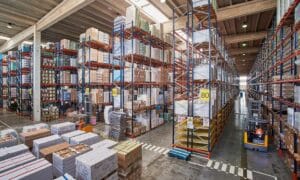 Unfortunately, getting there isn’t easy.
Unfortunately, getting there isn’t easy.
While more supply chain orgs are embracing AI, few have realized the full promise of their investments.
A joint study by BCG and Aera Technology sought to find out why, and unsurprisingly, the problem was largely related to the humans implementing the tech — not the tech itself.
AI has the potential to manage end-to-end workflows, make decisions, and self-regulate with very little human intervention.
According to BCG, orgs need to deploy fully-integrated, AI learning systems that leverage all enterprise data with external insights to reap the full promise of predictive analytics tools.
Unfortunately, many supply chain organizations don’t have the skills or expertise they need to execute the kinds of AI strategies described in that report — which, for the record, was published in September 2022.
The thing about AI is, it’s constantly evolving.
Microsoft’s most recent IoT Signals survey found that 28% of respondents are using digital twins, which generate digital replicas of assets, facilities, or products.
And, another report from IBM revealed a growing number of orgs are exploring solutions that combine AI with other emerging tech. Think — advanced automation, edge computing, blockchain, and the IoT.
Which means, at least some of those companies are rolling out AI initiatives before developing the foundational skills they need to support them.
On top of that, we’re currently in the midst of a major “generative AI wave,” which, in many ways, promises to make AI more accessible to all end-users.
For example, D365 SCM’s new Copilot features (in limited preview) helps users leverage generative AI to enhance predictive insights and take action on potential disruptions.
The bot analyzes historical insights, business data, and intelligence from the built-in news module, then flags any external issues that could impact key links in the supply chain such as inventory, logistics, orders, and more. It also can use that information to draft emails to your suppliers to start working on a new plan.
Again, the big challenge with Copilot and other gen AI tools such as ChatGPT lies in developing the skills and strategies needed to effectively use them.
Deloitte put together an excellent resource that covers topics like what gen AI can and can’t do, how it helps orgs create value from complex data sets, and why it works best when used with humans, not instead of them.
Here’s an example we pulled from that guide, which outlines a few simple steps for identifying gen AI use cases.
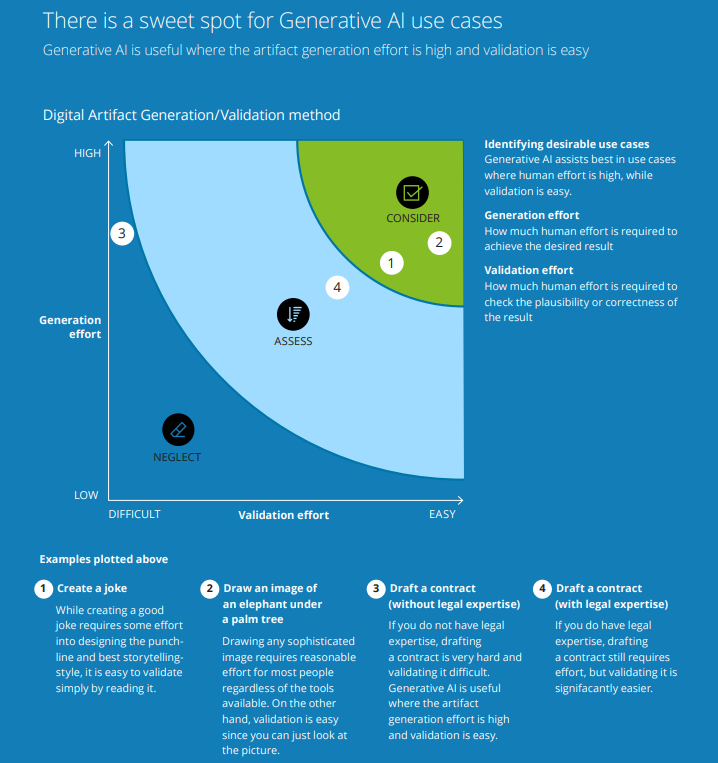
With all that in mind, let’s switch gears and look at some of the more established use cases for AI in the supply chain.
According to Supply Chain Dive, AI represents a new frontier in supply chain forecasting and planning.

Now that AI is in the picture, demand planning and forecasting is a breeze. In a matter of minutes, it can generate reports that once took weeks, even months, to pull together.
Algorithms can analyze vast amounts of data in real-time, identifying patterns and trends that humans might miss.
SCM tools like D365 Supply Chain Management uses AI to generate intelligent, data-driven forecasts. Algorithms continuously look for changes within all observed variables and scan the digital landscape for new ones that might have an impact on the forecasting process.
Built-in logic updates forecast in real-time, as the system captures new insights and incorporates “lessons learned” into predictive models, forecasts, and policies to enhance supply chain performance.
As an example, say you’re using AI analytics to interpret demand signals. The algorithm can identify changing customer behaviors mid-evolution and make adjustments to the processes and reporting tools used to inform inventory and product planning decisions.
This allows orgs to optimize stock levels based on predicted demand. It also plays a role in developing products, as well as the go-to market plans that support those new offerings.
Done right, AI inventory management enables orgs to strike the right balance – leading to improved customer satisfaction, cost savings, and a healthier bottom line.
Already, many supply chain organizations are successfully using AI to optimize inventory and weather ongoing materials shortages.
AI is great at predicting demand patterns and can be used to create dynamic workflows that use those insights to adjust stock levels accordingly. This gives companies a layer of protection by helping them avoid overstock scenarios as well as stockouts – both of which come with their own set of risks.
For example, you can set rules that automatically enforce purchasing limits on low-stock items or define hierarchies that determine allocations by group.
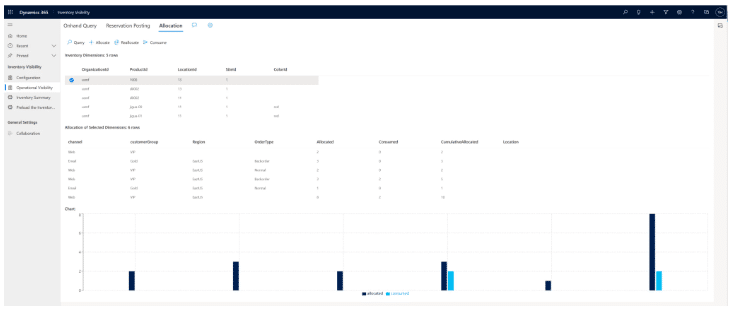
AI can also enhance logistics and transportation operations by optimizing routes, improving delivery times, and reducing fuel consumption. This not only saves costs but also reduces the environmental impact of supply chain operations.
AI captures and analyzes these huge volumes of logistics data – available stock by warehouse, shipping times, materials shortages, ETAs & delays, fleet locations, and so on. It then presents that information in a way that humans can understand — and, more importantly, put into action.
For example, if you’re using Dynamics 365 Supply Chain Management, there’s a feature that allows you to leverage information like on-hand inventory and future availability by fulfillment center to determine where to route orders based on goals like speed, sustainability, or fuel costs.
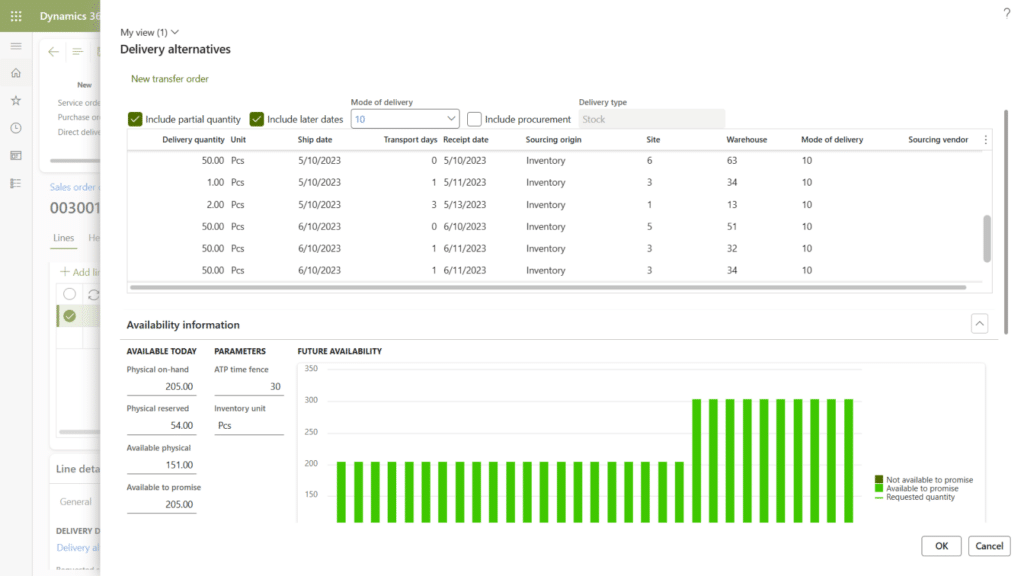
AI can also be used to optimize other aspects of logistics operations like how to best load shipping containers to maximize available space.
Real-time tracking and visibility through IoT and AI sensors also allows companies to tackle the dreaded “last mile” with relative ease.
Supply chain management covers everything from sourcing and supplier relations to production runs, customer service, and the countless logistics challenges that hang over all global supply chains.
With all those variables in the mix, there’s only so much human SCM pros can do to ensure everything goes according to plan.
All this makes AI crucial for detecting and mitigating supply chain risks – whether that’s in the form of disaster, disruption, or problematic suppliers.
For example, by flagging early warning signs and suggesting alternative options, AI enables supply chain leaders to proactively manage potential disruptions and take steps to minimize their impact.
D365 users can also run what-if analyses, which use AI and machine learning to model different scenarios and analyze the impact of different variables.
This not only helps SCM leaders prepare for future change and disruption. It allows them to explore the potential of new suppliers and regions, and gives them compelling insights they can use to support negotiations with both suppliers and their customers.
Companies are also starting to explore the potential of using generative AI to manage risks.
Siemens partnered with Microsoft to build their own generative AI solution. They combined Teams with Azure OpenAI and other Azure services to enhance factory automation, cross-functional collaboration, and innovation.
While the platform’s next-gen AI supports a long list of goals, it helps Siemens mitigate risks by identifying and preventing product defects.
Quality management teams now have the ability to quickly spot variances in the production cycle – and make adjustments in real-time. They can also scale and enforce QC standards so that product variances never have to happen in the first place.
A recent MIT Sloan survey found that 70% of global executives agree that enhancing KPIs, as opposed to simply improving performance, is critical to their long-term success.
One participant told researchers that they need to constantly evolve KPIs, otherwise, they’re running their business on legacy metrics.
34% of participants say their business is already using AI to create new KPIs. But — within that group, an impressive 90% reported seeing KPIs improve.
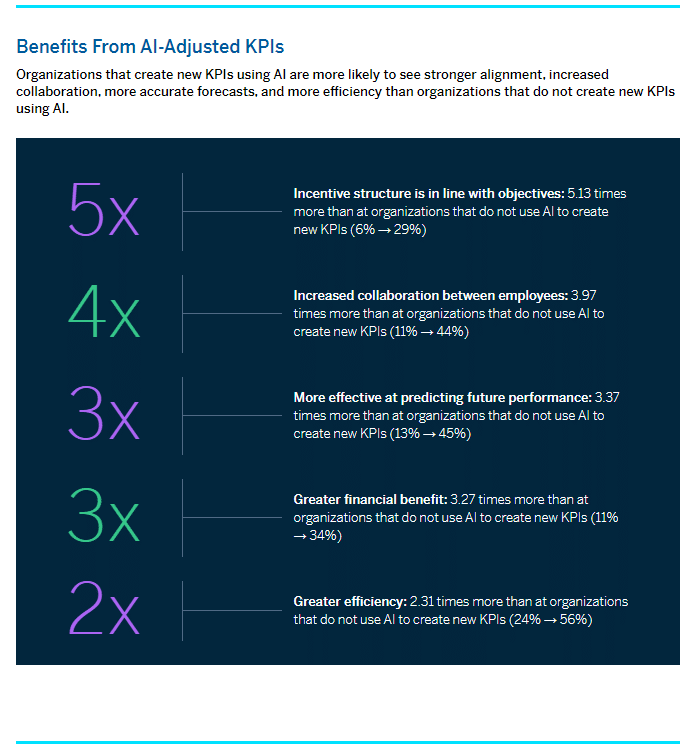
For those on the opposite end of the AI spectrum, the findings confirmed something most of us already knew deep down: on its own, human intuition is a liability.
Fewer than one third of the participants relying solely on human judgment to manage metrics saw any improvement to KPIs.
In a recent article, Velosio Consulting Manager Jeff Johnson explains how supply chain orgs can use an analytics platform like Power BI to generate distributor scorecards to track performance goals across six key areas:
If you’re working from a centralized platform, you can use AI to capture data related to each of these areas, then automatically update goals and metrics based on its findings.
Whether you’re just starting your AI journey or can’t wait to unleash Copilot on your supply chain, Velosio can help you transform your supply chain with intelligent solutions from the Microsoft stack.
How can Copilot affect your company’s workflow and goals? Contact us to learn the benefits of Copilot and how it can impact your company’s workflow for the better.